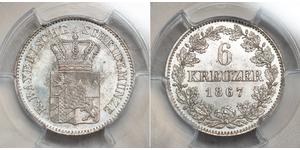(sold for $81.0)
1572, Spanish Netherlands, Philip II. Copper "Battle of Lepanto" Medal. Scarce!
Condition: XF! Mint Year: 1572 Reference: Dugn.2560. Denomination: Medal - Battle of Lepanto / Birth of the Infante Fernando during 1572 Material: Copper Diameter: 29mm Weight: 4.74gm
Obverse: Venetian galley (Venice was the main supplier of the battleships for this engagement) filled with military and naval trophies. Legend: TVRCAE CLASSE DEVICTA ("The Turks put to flight.")
Reverse: Abundance with cornucopiæ, stands with peacock and infant. Date (1572) in exergue. Legend: IAM NONA PROGENIES
The Battle of Lepanto was a naval engagement that took place on 7 October 1571 when a fleet of the Holy League, a coalition of Catholic Christian states arranged by Pope Pius V, inflicted a major defeat on the fleet of the Ottoman Empire in the Gulf of Patras. The Ottoman forces were sailing westward from their naval station in Lepanto (the Venetian name of ancient Naupactus—Greek Ναύπακτος, Ottoman İnebahtı) when they met the fleet of the Holy League which was sailing east from Messina, Sicily. The Spanish Empire and the Venetian Republic were the main powers of the coalition, as the league was largely financed by Philip II of Spain and Venice was the main contributor of ships.
In the history of naval warfare, Lepanto marks the last major engagement in the Western world to be fought almost entirely between rowing vessels, namely the galleys and galeasses which were the direct descendants of ancient trireme warships. The battle was in essence an "infantry battle on floating platforms". It was the largest naval battle in Western history since classical antiquity, involving more than 400 warships. Over the following decades, the increasing importance of the galleon and the line of battle tactic would displace the galley as the major warship of its era, marking the beginning of the "Age of Sail".
The victory of the Holy League is of great importance in the history of Europe and of the Ottoman Empire, marking the turning-point of Ottoman military expansion into the Mediterranean, although the Ottoman wars in Europe would continue for another century. It has long been compared to the Battle of Salamis, both for tactical parallels and for its crucial importance in the defense of Europe against imperial expansion. It was also of great symbolic importance in a period when Europe was torn by its own wars of religion following the Protestant Reformation. Pope Pius V instituted the feast of Our Lady of Victory, and Philip II of Spain used the victory to strengthen his position as the "Most Catholic King" and defender of Christendom against Muslim incursion. Historian Paul K. Davis writes that,
"More than a military victory, Lepanto was a moral one. For decades, the Ottoman Turks had terrified Europe, and the victories of Suleiman the Magnificent caused Christian Europe serious concern. The defeat at Lepanto further exemplified the rapid deterioration of Ottoman might under Selim II, and Christians rejoiced at this setback for the Ottomans. The mystique of Ottoman power was tarnished significantly by this battle, and Christian Europe was heartened."
em>.
Philip II, King of Spain 1556-1598. Son of Emperor Charles V (King Charles I of Spain), founder of the Spanish line of Habsburg. * 1527 Valladolid, †1598 Escorial near Madrid. Philip II received from his father the following contries: in 1540 the Duchy of Milan, in 1554 the Kingdoms of Naples and Sicily and in 1555/56 the Netherlands, the Franche-Comté and Spain with its colonies. In 1580 Philip also claimed and took over Portugal. He strove for Spanish world supremacy and fought for the counter-reformation. He was married four times: Maria of Portugal (*1526, †1545 following the birth of Don Carlos), Queen Mary Tudor of England (1554, †1558), Elizabeth of Valois, daughter of King Henry II of France (1559, †1568) and finally, in 1570, Anna of Austria, daughter of Emperor Maximilian II. King Philip II fought successfully against France (1557-1559), against the Turks (Juan d'Austria's victory near Lepanto in 1571) and against Mediterranean pirates. However, his attempt to conquer England failed (destruction of the Armada in 1588, sea-battle of Cádiz in 1596), as did his efforts to subdue the revolting Netherlands (secession of the northern provinces). Philip's ongoing war efforts overstrained his financial and economic resources and eventually led to the decline of Spanish supremacy.
Only 1$ shipping for each additional item purchased!

|
Posted by:
anonymous 2020-12-30 |
6 Kreuzer Kingdom of Bavaria (1806 - 1918) Silver Ludwig II ...
group has 2 coins
⇑







-300-150-cVAhwJflFy0AAAGLltZTnYLB.jpg)






